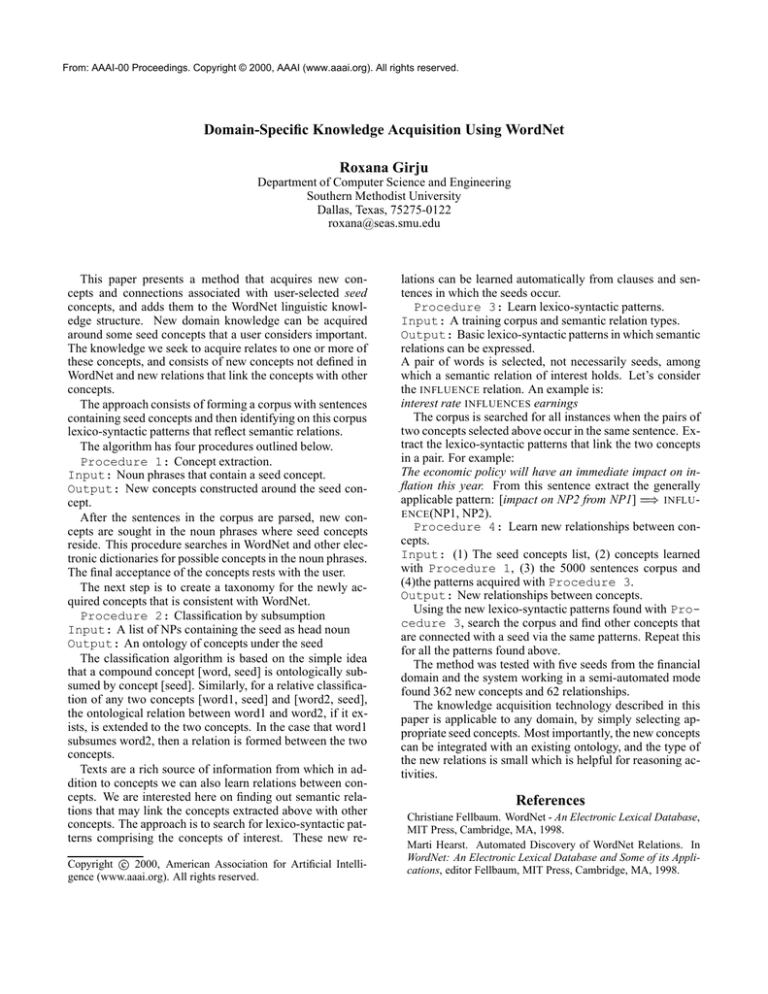
From: AAAI-00 Proceedings. Copyright © 2000, AAAI (www.aaai.org). All rights reserved.
Domain-Specific Knowledge Acquisition Using WordNet
Roxana Girju
Department of Computer Science and Engineering
Southern Methodist University
Dallas, Texas, 75275-0122
roxana@seas.smu.edu
This paper presents a method that acquires new concepts and connections associated with user-selected seed
concepts, and adds them to the WordNet linguistic knowledge structure. New domain knowledge can be acquired
around some seed concepts that a user considers important.
The knowledge we seek to acquire relates to one or more of
these concepts, and consists of new concepts not defined in
WordNet and new relations that link the concepts with other
concepts.
The approach consists of forming a corpus with sentences
containing seed concepts and then identifying on this corpus
lexico-syntactic patterns that reflect semantic relations.
The algorithm has four procedures outlined below.
Procedure 1: Concept extraction.
Input: Noun phrases that contain a seed concept.
Output: New concepts constructed around the seed concept.
After the sentences in the corpus are parsed, new concepts are sought in the noun phrases where seed concepts
reside. This procedure searches in WordNet and other electronic dictionaries for possible concepts in the noun phrases.
The final acceptance of the concepts rests with the user.
The next step is to create a taxonomy for the newly acquired concepts that is consistent with WordNet.
Procedure 2: Classification by subsumption
Input: A list of NPs containing the seed as head noun
Output: An ontology of concepts under the seed
The classification algorithm is based on the simple idea
that a compound concept [word, seed] is ontologically subsumed by concept [seed]. Similarly, for a relative classification of any two concepts [word1, seed] and [word2, seed],
the ontological relation between word1 and word2, if it exists, is extended to the two concepts. In the case that word1
subsumes word2, then a relation is formed between the two
concepts.
Texts are a rich source of information from which in addition to concepts we can also learn relations between concepts. We are interested here on finding out semantic relations that may link the concepts extracted above with other
concepts. The approach is to search for lexico-syntactic patterns comprising the concepts of interest. These new re-
Copyright c 2000, American Association for Artificial Intelligence (www.aaai.org). All rights reserved.
lations can be learned automatically from clauses and sentences in which the seeds occur.
Procedure 3: Learn lexico-syntactic patterns.
Input: A training corpus and semantic relation types.
Output: Basic lexico-syntactic patterns in which semantic
relations can be expressed.
A pair of words is selected, not necessarily seeds, among
which a semantic relation of interest holds. Let’s consider
the INFLUENCE relation. An example is:
interest rate INFLUENCES earnings
The corpus is searched for all instances when the pairs of
two concepts selected above occur in the same sentence. Extract the lexico-syntactic patterns that link the two concepts
in a pair. For example:
The economic policy will have an immediate impact on inflation this year. From this sentence extract the generally
applicable pattern: [impact on NP2 from NP1] = INFLU ENCE (NP1, NP2).
Procedure 4: Learn new relationships between concepts.
Input: (1) The seed concepts list, (2) concepts learned
with Procedure 1, (3) the 5000 sentences corpus and
(4)the patterns acquired with Procedure 3.
Output: New relationships between concepts.
Using the new lexico-syntactic patterns found with Procedure 3, search the corpus and find other concepts that
are connected with a seed via the same patterns. Repeat this
for all the patterns found above.
The method was tested with five seeds from the financial
domain and the system working in a semi-automated mode
found 362 new concepts and 62 relationships.
The knowledge acquisition technology described in this
paper is applicable to any domain, by simply selecting appropriate seed concepts. Most importantly, the new concepts
can be integrated with an existing ontology, and the type of
the new relations is small which is helpful for reasoning activities.
)
References
Christiane Fellbaum. WordNet - An Electronic Lexical Database,
MIT Press, Cambridge, MA, 1998.
Marti Hearst. Automated Discovery of WordNet Relations. In
WordNet: An Electronic Lexical Database and Some of its Applications, editor Fellbaum, MIT Press, Cambridge, MA, 1998.







